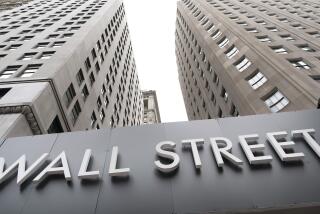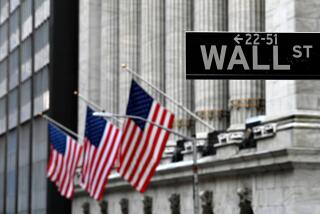‘99 Brings Astounding Gains in Tech, Other Funds
- Share via
What looked to be an ordinary year for stock mutual funds turned extraordinary in the final months of 1999, sending many funds into uncharted territory and adding to the legend of the ‘90s bull market.
For an unprecedented fifth consecutive year, the average domestic stock fund posted double-digit returns.
Yet that seemed a highly unlikely thing at the end of the third quarter--when the average fund was up just 5.1% for the year. But a 19.7% fourth-quarter surge powered domestic funds to an average gain of 27.5% for 1999, according to Morningstar Inc.
That topped the performance of the Standard & Poor’s 500 index of blue chip stocks by nearly 7 percentage points--marking the first time since 1993 that the typical fund beat the benchmark index.
Even so, a greater number of active fund managers trailed the S&P; than beat it. According to fund tracker Lipper Inc., only 46.4% of all U.S. diversified stock funds beat the S&P.;
Still, the fund business regained credibility in 1999. For starters, really active managers--”momentum” players such as Garrett Van Wagoner, manager of Van Wagoner Emerging Growth, which gained 291% in 1999--led the market, reminding small investors what professional portfolio management can achieve.
Also for the first time since 1993, international stock funds did better than domestic stock funds last year, posting average gains of 49.6%, amid promising signs of recovery in Asian and other emerging-market economies.
And for the first time ever, the average fund in two separate categories doubled investors’ money in a single calendar year: Thanks to a rising yen and what looks more and more like an economic rebound in Japan, the average Japan fund surged more than 121%. Here at home, a host of technology-stock funds posted triple-digit returns, fueled by the phenomenal end-of-1999 surge in those stocks.
Yet the stock fund universe, like the U.S. stock market overall, was a world of haves and have-nots. Seven Morningstar fund categories posted either single-digit or negative returns for the year. And 14 stock funds found a way to lose more than 25% of their value.
Some of the themes that dominated the stock-fund industry in 1999:
* Big risks, big returns: If taking high risk is supposed to lead to high returns, then off-the-chart risk must lead to off-the-chart returns. Or so investors in many technology stock funds must now assume.
The average tech fund soared 136.5% in 1999, the largest calendar-year gain for any fund category in U.S. history.
The hottest stocks, of course, were Internet-related start-ups with no earnings and barely much in sales--extremely high-risk issues.
And so among tech funds, “the guys with the nerve to double up on tech and Internet plays did the best,” says Bill Dougherty, fund analyst with the consulting firm Kanon Bloch Carre in Boston.
Loading up on telecommunications stocks also worked. The average telecom fund, fueled by 1,000%-plus gains in stocks such as Qualcomm and InterDigital Communications, soared 37.2% for the fourth quarter and 72.2% for the year.
That made telecom the second-best category of funds in the 1990s--after tech funds, which produced average annual gains of 54.1% for the last three years and 29% for the decade.
The hottest tech fund of all in 1999: Nicholas-Applegate Global Technology. This 18-month-old $129-million fund did something once thought impossible in the dowdy world of funds: Investing in tech stocks worldwide, it turned $1 into nearly $6 in just one year, setting an all-time record for fund performance and making the old record holder, the Internet Fund, look like a value play.
(Investors interested in the Nicholas-Applegate fund can call [800] 551-8643 for more information, but note: The minimum investment is $250,000.)
Is the tech mania just a huge bubble about to burst? Says Marshall Acuff, veteran stock strategist at Salomon Smith Barney in New York: “While investors may feel the need to re-balance their portfolios away from the technology and communications sectors, we believe that strong drivers in these sectors will continue to lead to relative earnings growth and, ultimately, stock price performance.”
* Smaller stocks, bigger returns: Investors finally began to focus on stocks outside the blue-chip world in 1999. And how.
For 1998, the average small-cap growth fund rose just 4%. But for 1999, many small-cap growth funds made themselves far more appetizing by making big bets on “dot-com” initial public offerings.
The result: The small-growth fund sector surged 41.4% for the quarter and 65.7% for the year. Similarly, the mid-cap growth sector rose 40.9% and 60.9%, respectively.
That marked the first year since 1996 that small-growth funds beat mid-cap growth funds. And both sectors trounced large-growth funds, which still managed respectable gains of 27.2% for the quarter and 39.1% for the year, on average--helped, of course, by heavy tech-stock weightings.
Merrill Lynch small-cap analyst Satya Pradhuman thinks this small-cap rally has legs. “This confirms our belief that a broader base of investors has begun to take notice of the valuation disparity between small and large companies,” he said.
* Even better over there: You name the region, you made money in foreign-stock funds in ’99.
Japan funds zoomed 25.2% for the quarter and 121.1% for the year, boosted in part by the yen’s surprising strength against the dollar.
Diversified Pacific-Asia funds jumped 33.2% for the quarter and 96% for the year. And driven not only by Asian holdings but also by big gains in Latin American markets, the average general emerging-markets fund shot up 35.6% for the quarter and 71.4% for the year--the sector’s best year since 1993.
Even Europe funds, which were essentially flat in the third quarter, surged 25.3% in the fourth quarter to finish the year up 26.9% on average. Their performance would have been even better but for the dollar’s strength against the euro currency, which cut the returns U.S. investors in Europe brought home.
But although they had a hot year, foreign funds remain laggards compared with U.S. stock funds measured over the last decade. That very fact, however, leads many analysts to believe that the foreign rally is just warming up.
Notes Barton Biggs, chief global strategist for Morgan Stanley Dean Witter in New York: “I’m convinced EAFE [that is, Morgan Stanley’s European, Australian and Far Eastern stock index] will beat the S&P; 500 and the Dow, and the U.S. will be the worst big market in the world” in 2000.
* Little value in value: Bringing up the rear in fund performance were value-stock funds--those that typically invest in shares of beaten-down or otherwise “cheap” stocks. Dazzled by technology, investors cared little for less-exciting shares that value investors called bargains.
The average large-cap value fund rose just 6.3% for the year--all of that in the fourth quarter. The average small-cap value fund added just 4.8% for the year.
At the start of the 1990s, value funds such as Sequoia Fund, Strong Schafer Value and Kemper-Dreman High Return Equity ruled the markets. Of course, dinosaurs once ruled the Earth too, and look what happened to them, say growth-stock managers.
Last year, those three well-known value funds fell 16.5%, 16.4% and 13.2%, respectively.
“Value stocks will have their day again,” says David Prichard, senior vice president at TCW Funds Management in Los Angeles. “People forget that value has beaten growth in five out of past 10 years.”
But a continuing problem for value funds is their often heavy investment in financial-services stocks.
Many of those stocks were as good as money in the bank in the 1990s. In fact, the average financial-services sector stock fund gained 18.5% a year in the decade, beating the 18% average for the S&P; 500.
But thanks to a bear market in insurance stocks and rising interest rates, the average financial fund fell 1.5% in 1999. It was one of only two categories of stock funds (the other: real estate funds, another interest-rate victim) that lost money in 1999.
Still, financial stock fans say that with the November repeal of Depression-era financial services laws, the pace of mergers in the industry should intensify, potentially lifting stock values.
*
Paul J. Lim can be reached by e-mail at [email protected].
More to Read
Inside the business of entertainment
The Wide Shot brings you news, analysis and insights on everything from streaming wars to production — and what it all means for the future.
You may occasionally receive promotional content from the Los Angeles Times.










